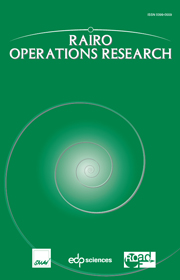No CrossRef data available.
Article contents
Process parameter prediction via markov modelsof sub-activities
Published online by Cambridge University Press: 21 March 2014
Abstract
This work aims to fill a lacunae in the project-oriented production systems literatureproviding a formal analytic description of the rework effects formulae and thedetermination of the extended design time due to a certain degree of overlapping in a pairof activities. It is made through the utilization of concepts of workflow constructionwith hidden (semi) Markov models theory and establishing a way to disaggregate activitiesinto sub-activities, in order to determine the activity parameters used by the projectscheduling techniques. With the aim to make a correlation between the entropy of the statetransitions and the probability of changes, the information theory is also used, and theconcept of impact caused by the probability of changes is provided. Numerical examples areshown for the purpose to demonstrate the applicability of the concepts developed, and oneexample of overlapping of two activities is shown. The original contributions of this workare shown on the last section.
Keywords
- Type
- Research Article
- Information
- Copyright
- © EDP Sciences, ROADEF, SMAI, 2014


